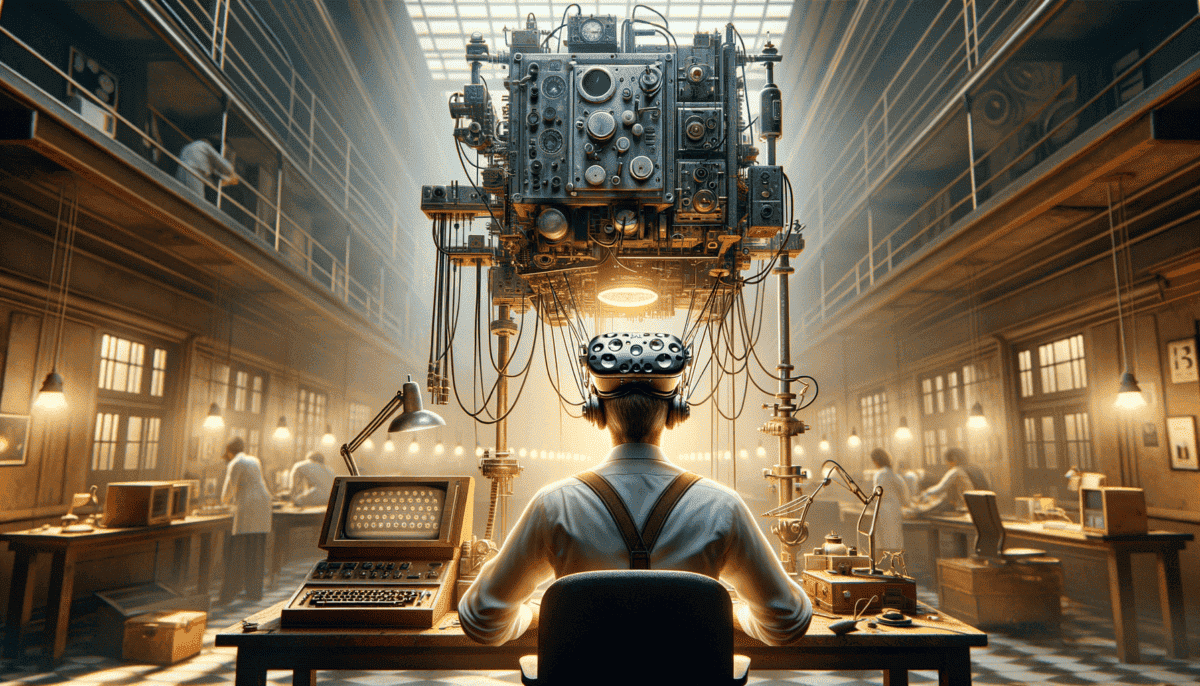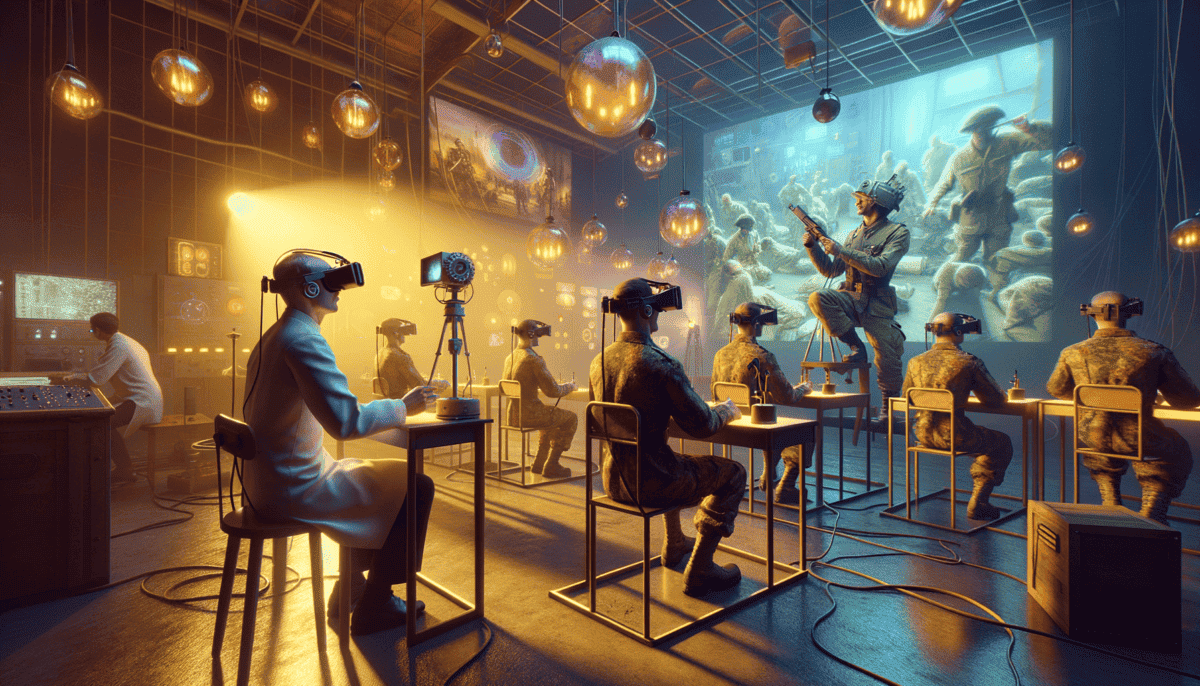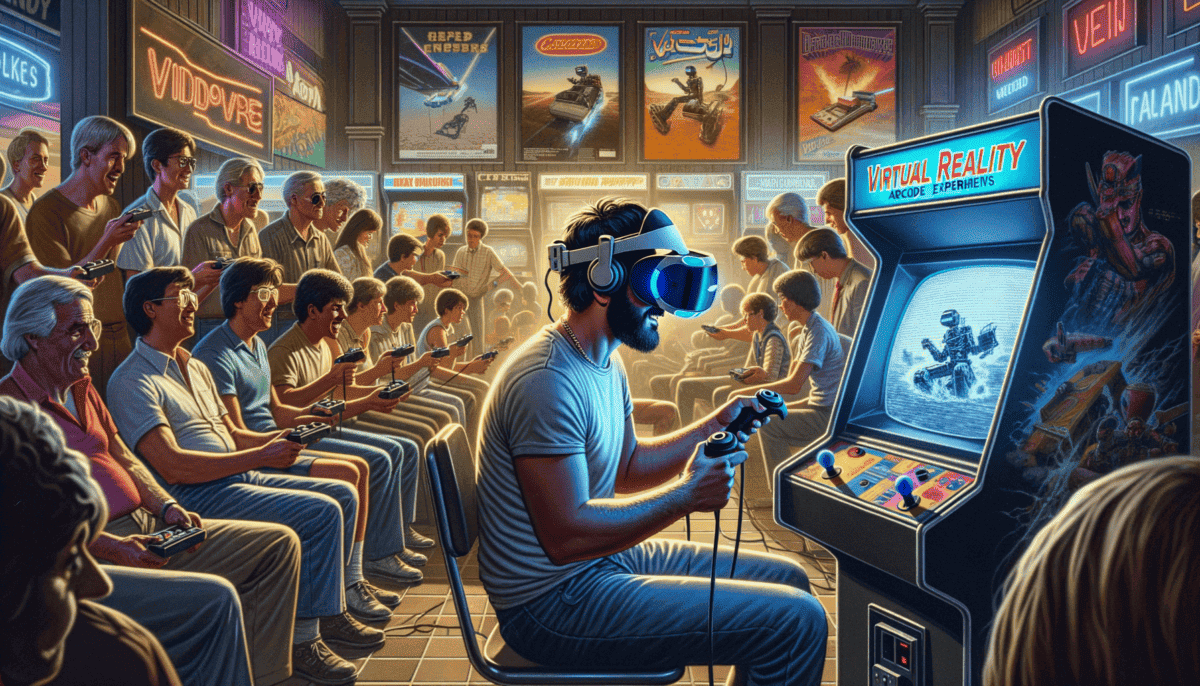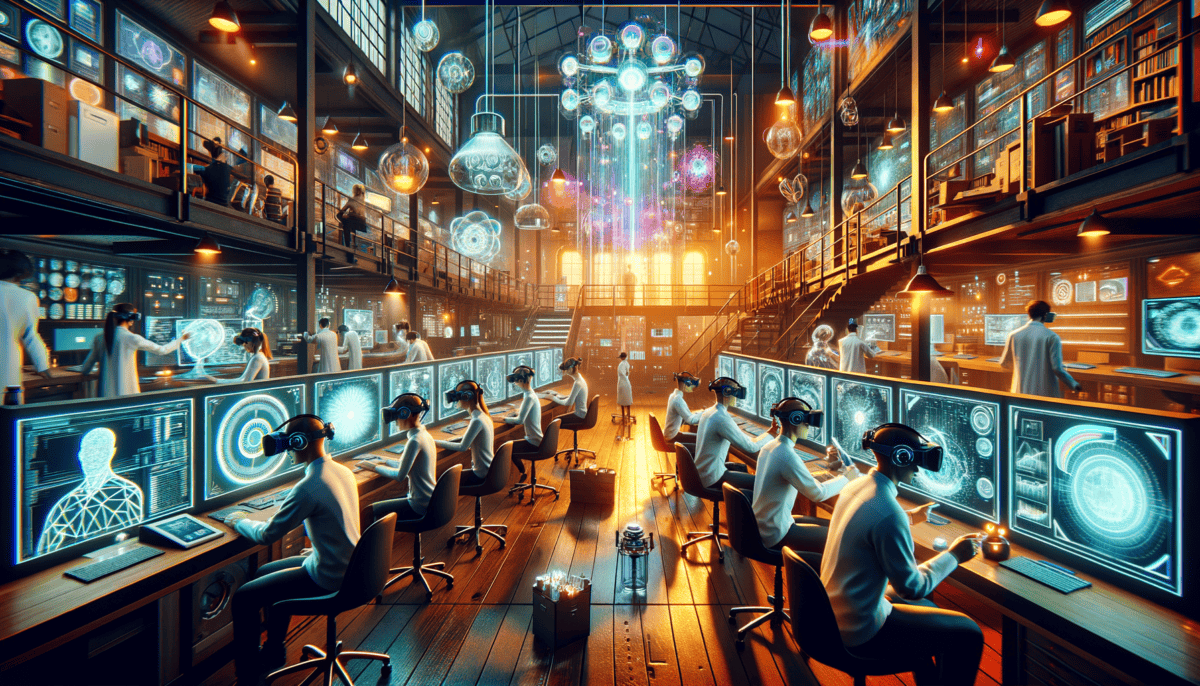A Dream of New Worlds
Morton Heilig sat at his workbench, his eyes twinkling with excitement. The year was 1957, and he had a big dream. He wanted to make movies that people could feel, smell, and touch – not just watch!
"What if…" Morton said to himself, sketching on a piece of paper, "what if people could really feel like they're inside the movie?"
His workshop was filled with bits and pieces of machinery. Tools scattered across the tables told the story of many late nights spent building something special. That something was called the Sensorama.
The Magic Box
The Sensorama looked like a big arcade game with a special seat where people could sit. It had a screen that wrapped around your face, kind of like wearing giant glasses. But this wasn't just any movie machine!
"When you ride a motorcycle in my Sensorama," Morton would explain to visitors, "you'll feel the wind in your hair. You'll smell the city air. You'll even feel the rumble of the motorcycle seat!"
Making Dreams Real
Building the Sensorama wasn't easy. Morton worked day and night, putting together:
• A special screen that showed 3D movies
• Fans that blew wind at just the right time
• Speakers that made sounds come from different directions
• A chair that could shake and move
• Smell makers that released different scents
Some people thought Morton was silly. "Movies are fine just the way they are!" they said. But Morton didn't listen. He knew he was creating something amazing.
The First Rides
Finally, the big day came! Morton invited people to try his invention. They sat in the special chair and went on amazing adventures. They rode motorcycles through Brooklyn, flew in airplanes, and even went on racing cars!
"Wow!" said one person after trying it. "I really felt like I was there!"
"It's like magic!" said another.
A New Beginning
Even though the Sensorama was super cool, it was very expensive to make. Morton couldn't find enough money to make more of them. But his dream didn't die – it grew bigger!
Other inventors saw what Morton had made and started thinking about new ways to make pretend worlds feel real. They called it "Virtual Reality."
Morton had planted a seed. His dream of making people feel like they could step into another world was just the beginning. More amazing inventions were coming, and the story of virtual reality was just getting started.
Every time someone today puts on VR goggles to play a game or learn something new , they're making Morton's dream come true. His Sensorama might sit quiet in a museum now, but the magic he started still lives on in all the virtual worlds we can visit today.
And somewhere, Morton Heilig is smiling, knowing that his crazy dream of making movies you could feel helped change the world.
The Sword Above
In a busy lab at Harvard University in 1968, something amazing was happening. Ivan Sutherland and his team were building a very special machine. They called it “The Sword of Damocles” ️
A Strange New Helmet
“It looks like a giant spider!” laughed Bob, one of Ivan’s helpers. The machine did look funny – it hung from the ceiling on a big metal arm, like a giant robot trying to give you a hat.
“That’s not a spider,” Ivan said with a smile. “That’s the future.”
Building Something New
The team worked hard every day. They had to solve tricky problems like:
• Making computer pictures that could change when you moved your head
• Building special screens that could sit right in front of your eyes
• Creating sensors that could tell where you were looking
“Why is it so heavy?” asked Sarah, another helper, trying on the headset.
“Because we’re carrying the future,” Ivan joked. “And the future weighs a lot!”
The Magic Lines
When you put on the headset, you saw something no one had ever seen before – simple shapes floating in the air! They were just green lines, but they looked like they were really there in the room with you.
“Look!” people would say. “I can walk around the shapes! They stay in place like they’re real!”
Making History
The machine was big and clunky. You had to be careful not to bump your head on the metal arm. But everyone who tried it knew they were seeing something special.
“One day,” Ivan told his team, “people will wear little glasses that can do this. They’ll use them to learn, play, and create amazing things!”
A New World Opens
The Sword of Damocles showed people something magical – that computers could create worlds we could step into. Even though the pictures were just simple lines, they opened up a whole new way of thinking about what computers could do.
Scientists and inventors everywhere got excited. They started thinking about new ways to make virtual reality better. Some worked on making the pictures more colorful. Others tried to make the headsets smaller and lighter.
Every VR headset today – from the ones people use to play games to the ones doctors use to learn about medicine – started with Ivan’s funny-looking ceiling machine. The Sword of Damocles might have looked scary, but it helped create a whole new kind of magic. ✨
Ivan’s team knew they had done something amazing. They had built a doorway into new worlds, and people were just starting to peek through it.
Training for Tomorrow
The big metal arm of the Sword of Damocles had shown people something amazing. Now, smart people in uniforms wanted to use this magic to train soldiers and astronauts!
Flying Without Wings
In a special room at NASA, Tom buckled himself into what looked like a toy airplane cockpit. He put on a funny helmet with screens inside.
“Ready for takeoff?” asked Dr. Martinez, pressing some buttons on a big computer.
Suddenly, Tom wasn’t in the room anymore – he was flying! The screens showed clouds and sky all around him.
Safe Practice
“This is amazing!” Tom said, moving the controls. “It feels so real!”
That was exactly what NASA wanted. Pilots could practice flying without using real planes. If they made mistakes, no one would get hurt. They could just try again!
Doctors in Training
In a hospital across the country, Dr. Sarah was using virtual reality too. She wore special goggles that showed her the inside of a human body.
“Now I can practice surgery without needing a real patient,” she explained to her students. “Watch this!”
The Military’s New Tool
The army had big plans for virtual reality too. They built special rooms where soldiers could practice:
• Driving tanks
• Flying helicopters
• Working as a team
• Finding their way in new places
• Fixing broken equipment
“It’s like a video game,” said Private Jones, “but we’re learning real skills!”
Learning New Things
Scientists found out that people learned better when they could practice in virtual reality. It was like having a magic classroom where you could try anything!
“When you do something yourself, you remember it better than just reading about it,” explained Dr. Martinez. “And in VR, you can do things that would be too dangerous or expensive in real life.”
Making Things Better
The military and NASA helped make virtual reality better. They spent lots of money to fix problems like:
Making the pictures clearer
Making the helmets lighter
Making everything feel more real
Adding sounds and movement
Beyond Training
Soon, scientists started thinking about other ways to use virtual reality. Maybe it could help:
Kids learn about space
Architects design buildings
Engineers test new machines
Artists create new kinds of art
A New Kind of Teacher
Virtual reality was becoming more than just a cool toy. It was turning into a powerful tool for learning and training. People could practice dangerous or difficult things safely.
“We’re not just playing games anymore,” said Dr. Martinez. “We’re building a new way to learn about our world.”
The military and science people had shown everyone that virtual reality could be useful. They helped turn Ivan’s dream into something that could help lots of people learn and grow.
Gaming Dreams Come True
The year was 1991, and something exciting was happening in shopping malls across America. Big colorful machines were appearing, promising to take kids into whole new worlds!
The Arcade Revolution
Joey pressed his face against the glass window of the mall arcade. Inside was something he’d never seen before – a huge machine with the words “Virtuality” glowing on top.
“What is that?” he asked his mom, pointing at the strange helmet attached to it.
“It’s virtual reality,” she explained. “Want to try it?”
A New Kind of Game
Joey put on the big plastic helmet. It was heavy, but he didn’t care. Suddenly, he was inside the game! He could look all around – up, down, everywhere!
“Wow!” he shouted. “I’m really in here!”
Other kids lined up to watch and wait for their turn. These machines cost $5 for just a few minutes of play, but everyone thought it was worth it.
The Virtual Boy
In 1995, Nintendo tried something new. They made a red and black game system called the Virtual Boy. It looked like robot binoculars on a stick!
But there were problems:
• The games were only in red and black colors
• It made some people's heads hurt
• You had to sit very still to play
• It was expensive
Learning from Mistakes
“Maybe we tried too soon,” said Mr. Yokoi from Nintendo. “The technology isn’t ready yet.”
He was right. People wanted virtual reality, but the machines needed to be:
✨ Lighter and more comfortable
✨ Less expensive
✨ Better looking
✨ More fun to play
Big Dreams, Small Steps
Even though some games didn’t work well, companies kept trying. They knew kids like Joey wanted to play in virtual worlds.
“One day,” said Joey’s mom, watching him play, “these games will be in everyone’s home.”
The Shopping Mall Mystery
By 1998, many of the big VR arcade machines disappeared. They were too expensive to fix when they broke.
“Where did all the VR games go?” Joey asked one day.
“They’re just taking a break,” his mom said. “They’ll be back better than ever!”
Never Giving Up
Game makers didn’t stop dreaming about virtual reality. They kept working on new ideas:
Better screens
Faster computers
Fun new games
Ways to move around while playing
The Promise of Tomorrow
Joey never forgot his first time trying VR in the mall. Even though the early games had problems, they showed everyone something amazing was coming.
“Virtual reality games were like magic,” Joey told his friends. “And someday, they’re going to be even better!”
The first wave of VR games had crashed, but it left behind big dreams and important lessons. Something new and exciting was just around the corner…
The New VR Wave
In 2012, something amazing happened in a small garage in California. A teenager named Palmer Luckey had a big dream about virtual reality.
A Young Inventor’s Dream
“I want to make VR that everyone can use,” Palmer told his friends. He took apart old VR headsets and built something new – the Oculus Rift.
Sarah, a young gamer, watched a video about Palmer’s invention online. “Mom, look!” she exclaimed. “VR is coming back!”
The Big Companies Join In
Soon, other companies wanted to make VR too:
HTC made the Vive
Sony created PlayStation VR
Facebook bought Oculus
Many more joined the fun
More Than Just Games
“Today, class,” Ms. Thompson said to her students, “we’re going to visit Ancient Egypt!”
The kids put on VR headsets and gasped. They were standing by the pyramids! VR wasn’t just for games anymore:
• Students explored space and history
• Artists made amazing 3D paintings
• People met friends in virtual worlds
Sarah’s VR Adventure
Sarah saved up her allowance and finally got her own VR headset. It was nothing like the old Virtual Boy her dad told her about.
“This is incredible!” she shouted, reaching out to touch virtual butterflies floating around her room.
Making Dreams Real
The new VR was different from the old days:
✨ The pictures looked real
✨ You could move around freely
✨ The headsets were comfortable
✨ There were lots of fun things to do
Helping People
Dr. Martinez used VR to help people overcome their fears. “It’s like magic,” she said. “People can face their fears in a safe place.”
Tommy was afraid of heights. In VR, he could practice being brave:
“I started on the first floor, then went higher and higher,” Tommy explained. “Now I can climb to the top of real buildings!”
A World of Wonder
VR started connecting people in new ways. Sarah made friends from all over the world in VR chat rooms.
“Where are you from?” she asked a girl with purple virtual hair.
“Japan!” the girl replied. “Want to explore a virtual underwater city together?”
Growing and Learning
Teachers found exciting ways to use VR:
Taking virtual field trips
Learning about the human body
Practicing new skills
Understanding complex ideas
The VR Revolution
Palmer’s dream had come true. VR wasn’t just a toy anymore – it was changing how people played, learned, and worked together.
“Remember when VR was just big arcade machines?” Sarah’s dad asked.
“Now it’s everywhere!” Sarah smiled, putting on her headset. “I wonder what it will do next…”
The digital renaissance had begun, but the story of VR wasn’t over. New adventures and discoveries were waiting just ahead… ⭐
The Next Frontier
Sarah sat in her room, watching the sunset through her VR headset. But this wasn’t just any sunset – it was a sunset on Mars!
Amazing New Ideas
“Mom!” Sarah called out. “Scientists made VR that you can feel!”
Her mom walked in, curious. “What do you mean, honey?”
“Look!” Sarah showed her mom a video of new VR gloves. “You can touch things that aren’t really there!”
Small But Mighty
The VR headsets were getting smaller and better:
Some looked like regular glasses
Others were light as a feather
Many worked without wires
Some even read your thoughts!
Making the World Better
Dr. Martinez smiled as she showed her new virtual therapy room. “Now I can help people anywhere in the world,” she said.
“Yesterday, I helped someone in Australia overcome their fear of spiders, and today I’m working with a student in Brazil!”
Learning Without Limits
Ms. Thompson’s class was different now. Every student had special VR contact lenses.
“Today,” she announced, “we’re going to build our own solar system!”
• Create virtual planets
• Walk on their creations
• Learn by doing
• Share with friends
The Big Change
“Remember the old Sensorama?” Sarah’s grandpa asked, showing her a picture.
“That big machine?” Sarah giggled. “Now we have full worlds in our pockets!”
Working Together
People everywhere used VR to connect:
Doctors did surgery from far away
Artists made huge virtual museums
Scientists explored tiny atoms
Friends played in virtual parks
The Dream Continues
Sarah sat with her virtual friend from Japan in their favorite spot – a floating castle in the clouds.
“What do you think VR will do next?” her friend asked.
Sarah thought for a moment. “Maybe we’ll visit other galaxies, or talk to dinosaurs, or…”
“Or maybe,” her friend added, “we’ll make whole new worlds no one has ever dreamed of!”
Looking Back and Forward
From Morton Heilig’s big Sensorama to Palmer’s garage invention, VR had come so far. But this wasn’t the end – it was just the beginning!
Every day, someone somewhere had a new idea for VR:
⭐ Making virtual food you can taste
⭐ Building cities in the sky
⭐ Traveling through time
⭐ Creating new ways to learn and play
The Adventure Goes On
As Sarah took off her VR glasses that evening, she smiled. The future was full of possibilities.
“What will we dream up next?” she wondered.
And somewhere, in garages and labs all over the world, people were already working on the answer – making dreams into reality, one virtual step at a time.






